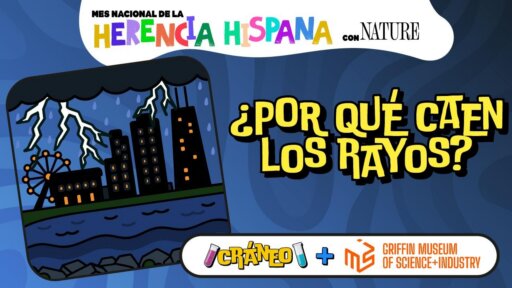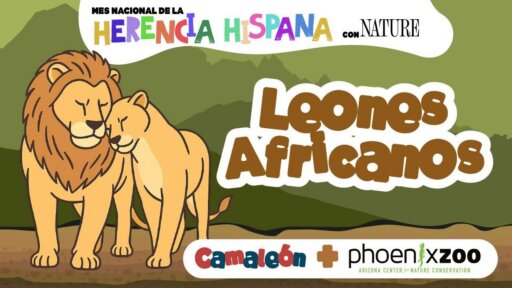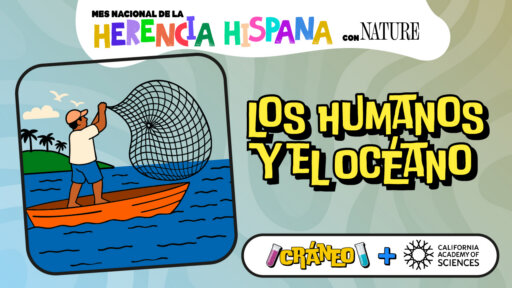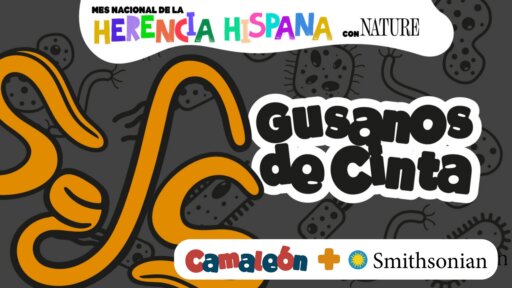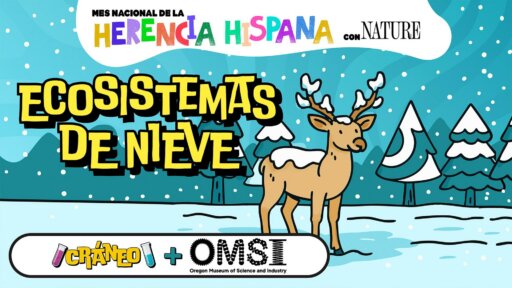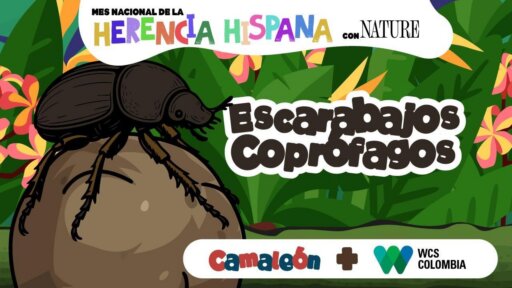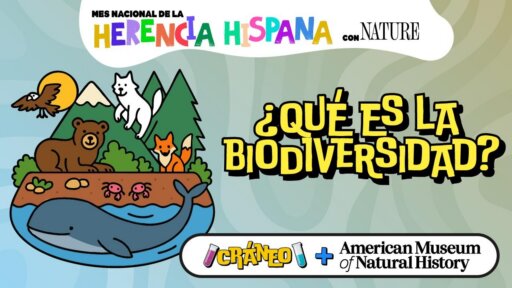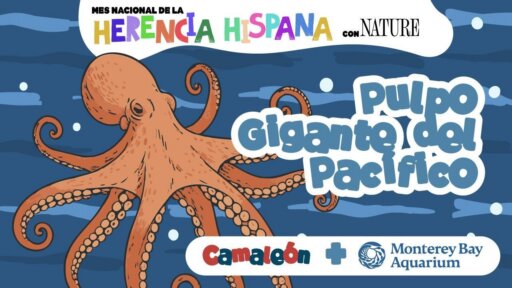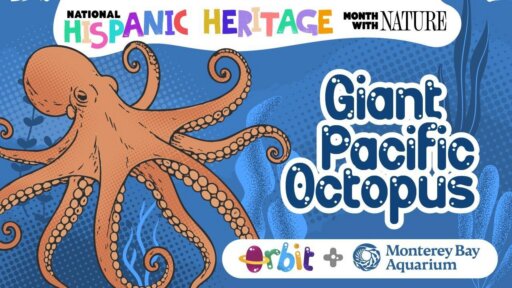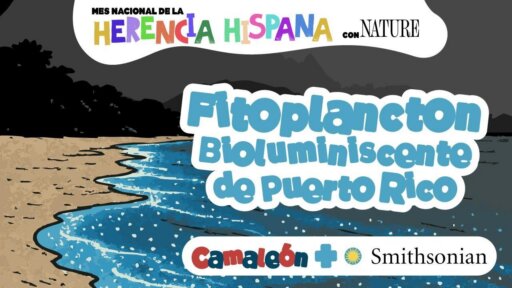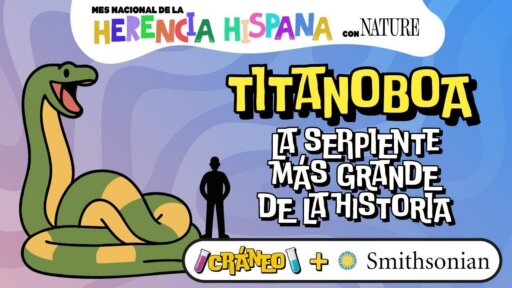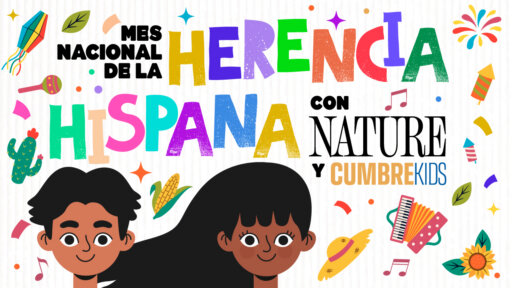TRANSCRIPT (EN)
00:00:01 Robert:
This episode of Orbit, Science for Kids on the Move is produced thanks to the amazing team at PBS Nature as part of a bilingual podcast series for National Hispanic Heritage Month. Thanks, PBS Nature.
00:00:16 Robert:
What up, Orbiters?
00:00:20 Robert:
We have a slithery, slimy, scientific adventure for you today.
00:00:25 Robert:
We’re jumping in our time machine and heading back 60 million years.
00:00:31 Robert:
to an age where the earth was a true land of giants.
00:00:36 Robert:
That’s right, giant turtles, giant crocodiles, giant plants, and yes, of course, giant snakes.
00:00:46 Robert:
In fact, the most giantest snake to have ever lived, the infamous titanoboa.
00:00:52 Robert:
And who better to join us on this journey than a scientist from the Smithsonian Tropical Research Institute?
00:00:58 Dr. Carlos
Hello, my name is Carlos Jaramillo, and I am a paleontologist.
00:01:02 Dr. Carlos
That is, someone who studied fossils to learn about life in the past.
00:01:06 Robert:
Carlos knows all about this incredible animal, and you sent us some pretty cool questions too.
00:01:14 Kids:
What was that Titanoboa?
00:01:16 Kids:
Why is the Titanoboa so big and fat?
00:01:21 Kids:
Did it eat a cow or an elephant or something?
00:01:24 Kids:
Did the Titanoboa live with the dinosaurs?
00:01:28 Kids:
It was like when Titanoboa lived?
00:01:31 Robert:
We don’t need a magnifying glass to discover this prehistoric monster. Grab your curiosity and your imagination and let’s go!
00:01:41 Robert:
Hey, Milam, can you give us a countdown from 5?
00:01:45 Milam:
Five, four, three, two, one, zero.
00:01:51 Robert:
Zero, action, record.
00:01:53 Robert:
Welcome to the podcast. I’m Rob.
00:01:56 Robert:
I’m here with Milam Howard joining us from Houston, Texas.
00:02:01 Robert:
Milam, welcome to the podcast.
00:02:05 Milam:
Thank you for having me.
00:02:06 Robert:
We’re so happy.
00:02:07 Robert:
We’re so happy to have you.
00:02:08 Robert:
I’m I hit Milam.
00:02:09 Robert:
This is our, this is our first episode together.
00:02:11 Robert:
We’ve talked in the past on podcast, but this is going to be the first one we publish.
00:02:16 Robert:
What is, let’s start off with like what’s going on in your life today, Milam?
00:02:21 Milam:
Tomorrow’s my first day of school.
00:02:23 Robert:
Oh, wow.
00:02:24 Robert:
What grade are you going into, Milam?
00:02:26 Milam:
Second grade.
00:02:27 Robert:
Are you feeling excited, anxious, nervous?
00:02:30 Milam:
Sad.
00:02:31 Robert:
You’re sad.
00:02:32 Robert:
What are you sad about?
00:02:34 Milam:
Summer being over.
00:02:36 Robert:
Yeah, summer is a really fun time.
00:02:38 Robert:
Do you have a good time with your brothers and with your parents this summer?
00:02:42 Robert:
Yeah.
00:02:42 Robert:
What did you do?
00:02:44 Milam:
I went on a fishing trip in Florida.
00:02:47 Robert:
Wow, you went on a fishing trip.
00:02:50 Robert:
Tell us about your fishing trip.
00:02:51 Milam:
So we were gonna go in the…
00:02:54 Milam:
to the ocean, but then the currents got way too strong, so we just had to fish in the bay.
00:03:01 Milam:
And I caught two blue fish and almost caught a Spanish mackerel.
00:03:08 Milam:
It bit me like it was attacking me for like 14 times.
00:03:13 Milam:
And then. But I didn’t get to catch it because it was so strong and then we left that area.
00:03:20 Robert:
Wow.
00:03:21 Robert:
It was attacking you personally or it was attacking the…
00:03:25 Milam:
It attacked my dad once, but it attacked me a lot.
00:03:29 Robert:
Like it was trying to eat the bait on your line.
00:03:33 Milam:
They did a lot.
00:03:34 Robert:
What kind of a boat were you on?
00:03:36 Robert:
What was the boat like?
00:03:38 Milam:
I don’t know what it’s called.
00:03:41 Milam:
But, so I don’t know.
00:03:42 Robert:
What was it?
00:03:43 Robert:
Was it a big boat or a small boat?
00:03:44 Milam:
Small boat.
00:03:46 Robert:
Did you have to row or did it have an engine and a motor?
00:03:49 Milam:
It had an engine.
00:03:51 Robert:
It had an engine?
00:03:51 Robert:
Did it go fast or slow?
00:03:53 Milam:
Kind of fast.
00:03:54 Robert:
Yeah.
00:03:55 Robert:
Did you, does, did you name the boat?
00:03:57 Milam:
No.
00:03:57 Robert:
Do you want to name the boat?
00:03:58 Robert:
We could probably name the boat right now.
00:04:00 Milam:
No.
00:04:02 Robert:
Okay.
00:04:02 Milam:
Yes.
00:04:04 Robert:
What would you name the boat?
00:04:06 Milam:
Lucy.
00:04:07 Robert:
Lucy.
00:04:07 Robert:
So you were on Lucy the boat, almost catching a Spanish mackerel and two blue fish.
00:04:14 Milam:
And I also caught one catfish.
00:04:19 Robert:
Wow.
00:04:20 Robert:
How big are we talking about a fish the size of your pinky finger, the fish the size of your hand, the size of your hand?
00:04:26 Milam:
No, probably, both of them are probably like this big.
00:04:31 Robert:
I don’t think our listeners can hear, know what this big is.
00:04:34 Robert:
Describe it with your words.
00:04:37 Milam:
It’s like probably about the size of my arm.
00:04:41 Robert:
The size of your arm, like maybe from like your elbow to your fingers.
00:04:47 Robert:
Yeah.
00:04:47 Robert:
that’s a pretty big fish.
00:04:49 Robert:
Was that your first time fishing in the bay like that?
00:04:53 Milam:
My first time fishing in a bay, but I’ve fished in bigger areas.
00:04:58 Robert:
Yeah?
00:04:59 Robert:
You’re like a professional fisherman.
00:05:01 Milam:
Yeah, I’m really good at fishing.
00:05:03 Milam:
Me and my…
00:05:04 Milam:
And also…
00:05:06 Milam:
I also, dad got a new DJ set.
00:05:11 Milam:
So now me and, so now I learned how to do it.
00:05:14 Milam:
So now me and dad are both really, really good.
00:05:18 Robert:
We have a DJ fisherman here and a podcast host.
00:05:22 Robert:
You’ve got all sorts of hobbies going on.
00:05:26 Robert:
So we’re going to talk about the Titanoboa.
00:05:28 Robert:
And, but first,
00:05:30 Robert:
We’re going to we’re going to try to set the set the scene.
00:05:33 Robert:
Milam, you’re going to invite us into your imagination.
00:05:36 Robert:
Is that OK?
00:05:37 Milam:
My imagination.
00:05:39 Milam:
OK, that’s true.
00:05:40 Robert:
Your imagination.
00:05:45 Robert:
OK, so what we’re what we’re going to do is we’re going to pretend that we’re going on a journey, and Milam is going to help us visualize that journey.
00:05:53 Robert:
So everybody, if you’re listening, you can close your eyes if you want to, or you can look at the ceiling or at the floor.
00:05:58 Robert:
And just imagine that we’re on this journey with Milam.
00:06:02 Robert:
And we’re looking for the Titanoboa.
00:06:07 Robert:
Milam, where are we?
00:06:09 Milam:
In the rainforest.
00:06:12 Robert:
We’re in a rainforest.
00:06:14 Robert:
And who are we with?
00:06:16 Milam:
I’m by, we’re by ourselves.
00:06:18 Robert:
Just you and me and our listening friends.
00:06:21 Milam:
Yes.
00:06:22 Robert:
Okay, perfect.
00:06:23 Robert:
So it’s a small group.
00:06:23 Robert:
We’re in a rainforest.
00:06:24 Robert:
What are we, what kind of clothes are we wearing?
00:06:26 Milam:
Pajamas with hiking boots.
00:06:30 Milam:
But the hiking boots are too big.
00:06:34 Robert:
Okay.
00:06:35 Robert:
So where everybody imagine your favorite pajamas, my favorite pajamas, they have little aliens on them.
00:06:43 Robert:
I also have some pajamas with dinosaurs on them.
00:06:45 Robert:
Milam, what do your pajamas look like?
00:06:48 Milam:
I have some pokémon ones.
00:06:49 Milam:
I have all kinds of ones.
00:06:53 Milam:
But remember, we have pajamas on, so that means we’re sleeping.
00:06:58 Milam:
It’s midnight.
00:06:59 Robert:
It’s midnight.
00:07:00 Robert:
Okay, so it’s the middle of the night in the rainforest with Milam, me, and our listeners.
00:07:06 Milam:
And the weather, and the weather is it’s raining.
00:07:12 Robert:
And it’s raining.
00:07:12 Robert:
Wow.
00:07:13 Milam:
It’s raining at midnight.
00:07:14 Robert:
It’s raining.
00:07:16 Robert:
Is it a thunderstorm?
00:07:17 Milam:
No, it’s just raining.
00:07:20 Robert:
Just raining and we’re in a tent.
00:07:21 Milam:
Actually, yeah, it’s a thunderstorm.
00:07:23 Milam:
It’s a thunderstorm.
00:07:24 Robert:
Okay.
00:07:24 Robert:
Now it’s, it just started thundering.
00:07:26 Robert:
It wasn’t thundering and now it is thundering.
00:07:28 Robert:
What kinds of things can we hear around us?
00:07:32 Milam:
We’re asleep, so we can’t hear them.
00:07:34 Robert:
But we just, okay, what if I just woke up?
00:07:38 Robert:
I’m in our tent, we’re in our, we’re in our tent, and I just woke up.
00:07:42 Robert:
What kind of things do I hear?
00:07:44 Milam:
Monkeys with wings.
00:07:50 Robert:
Monkeys with wings.
00:07:51 Milam:
That are savage killers.
00:07:55 Milam:
They fight to death.
00:07:56 Robert:
Wow.
00:07:56 Robert:
These are, these are very scary, scary monkeys that we’re surrounded by.
00:08:00 Robert:
I bet we can also hear, can we hear thunder?
00:08:04 Milam:
No, only the breath of crocodiles.
00:08:12 Robert:
Okay.
00:08:13 Robert:
So we hear we hear savage monkeys, the breath of crocodiles.
00:08:18 Robert:
Are there any insects?
00:08:19 Robert:
Can we hear like crickets?
00:08:22 Milam:
No.
00:08:23 Robert:
What about frogs?
00:08:23 Milam:
Only the giant centipede.
00:08:25 Milam:
That’s 8 feet.
00:08:27 Robert:
Wow.
00:08:28 Robert:
And an 8 foot centipede.
00:08:30 Milam:
That’s a real dinosaur.
00:08:32 Robert:
Yeah.
00:08:34 Robert:
But dinosaurs are reptiles.
00:08:35 Robert:
So I think this one would be a prehistoric insect.
00:08:40 Robert:
Okay, something is moving.
00:08:45 Robert:
It looks like a huge snake.
00:08:48 Milam:
I think it’s a Titanoboa.
00:08:51 Robert:
You think it’s a Titanoboa?
00:08:52 Robert:
What color is it?
00:08:53 Milam:
Red, black, gold.
00:08:55 Robert:
Red, black, and gold.
00:08:57 Robert:
Is it polka dots or is it stripes?
00:08:59 Milam:
It’s patterns.
00:09:01 Robert:
It’s patterns.
00:09:02 Robert:
And what is the Titanoboa doing?
00:09:05 Milam:
Sneaking up on us.
00:09:07 Robert:
Oh, this is quite scary.
00:09:10 Robert:
In the dark, we’ve got a large red, black, and gold Titanoboa sneaking up on us.
00:09:16 Robert:
And do we get closer to it or do we run away?
00:09:20 Milam:
We get closer.
00:09:22 Robert:
You are braver than I am, Milam.
00:09:24 Robert:
And what happens next?
00:09:27 Milam:
We get eaten.
00:09:31 Robert:
No.
00:09:33 Milam:
That’s what this says.
00:09:35 Robert:
Yeah.
00:09:36 Milam:
That’s what my cheat sheet says.
00:09:39 Robert:
That is what your cheat sheet says.
00:09:40 Robert:
I think you decided to have us get eaten.
00:09:44 Robert:
It’s a great story with a sad ending.
00:09:47 Robert:
Everybody, welcome to Milam’s imagination, where there are haunted monkeys and giant centipedes, and we’re all wearing pajamas when we get eaten.
00:09:59 Robert:
Okay, we’re going to do, Milam, are you ready to learn about the Titanopa?
00:10:03 Milam:
Yes.
00:10:04 Robert:
Okay, awesome.
00:10:05 Robert:
Today’s episode is going to feature Dr. Carlos from the Smithsonian Tropical Research Institute.
00:10:11 Robert:
Milam, why don’t you say hi to Dr. Carlos.
00:10:14 Milam:
Hi, Dr. Carlos. Welcome to the podcast.
00:10:17 Milam:
What do you do for work?
00:10:18 Dr. Carlos
Hello, my name is Carlos Jaramillo.
00:10:21 Dr. Carlos
and I am a paleontologist, that is, someone who studied fossils to learn about life in the past.
00:10:29 Dr. Carlos
I work at the Smithsonian Tropical Research Institute in Panama City, Panama, a country in Central America.
00:10:36 Robert:
Whoa, Panama!
00:10:38 Robert:
That sounds cool.
00:10:39 Dr. Carlos
Look at a map and see where it is, the smallest strip of land separating the Atlantic and the Pacific Oceans.
00:10:46 Robert:
That’s right.
00:10:47 Robert:
Panama is a country that connects North America, where we find the United States, Mexico, and Canada, with South America, and countries like Colombia, Brazil, Venezuela, and Argentina.
00:10:58 Robert:
Well, I am very excited to learn about the Titanoboa with Dr. Carlos.
00:11:02 Robert:
Hey, Milam, are you ready to get started?
00:11:04 Milam:
Definitely, yes.
00:11:06 Robert:
Definitely, yes.
00:11:07 Robert:
Let’s do this.
00:11:10 Robert:
Hey there, adults.
00:11:12 Robert:
Does your little one want to submit questions for future episodes of Orbit?
00:11:15 Robert:
Visit www.cumbrekids.org/questions and fill out the short form.
00:11:23 Robert:
We’ll add you to our WhatsApp to submit your kids’ questions.
00:11:26 Robert:
You can also submit questions for our Spanish language podcasts, Cráneo and Camaleón.
00:11:32 Robert:
That website again is www.cumbrekids.org/questions.
00:11:38 Robert:
or you can visit the link in the show notes.
00:11:41 Robert:
Okay, let’s get back to Dr. Carlos.
00:11:45 Robert:
Okay, Dr. Carlos, you are now in the hot seat.
00:11:48 Robert:
Let’s get started with maybe the most important question of them all.
00:11:53 Damika:
Hi, my name is Damika. I live in Venezuela. I am eight years old. And my question is, what was the Titanoboa?
00:12:05 Javier:
Hello, my name is Javier Matias Padilla Caro. I’m six years old. I’m from Tunga, Colombia. And my question is, what was the Titanoboa?
00:12:16 Igrid:
Hello, my name is Igrid Mostajo. I am nine years old. I live in Santa Cruz, Bolivia. And my question is, what was the Titanoboa? Thank you, bye.
00:12:30 Dr. Carlos
Titanoboa was a giant snake, the biggest one that has ever lived.
00:12:36 Dr. Carlos
It was about 40 feet long.
00:12:38 Dr. Carlos
Can you imagine that? That’s about the same as 30 big steps. Next time you have space, try walking three steps and you will see how long.
00:12:47 Robert:
Holy jamolies, 30 steps?
00:12:49 Robert:
Families, this is a great chance to pause the episode and go outside to take 30 steps together to see just how long a titanoboa was.
00:12:57 Robert:
Kids, just make sure you’re with an adult you trust.
00:13:00 Robert:
You can pause now and resume whenever you’re ready.
00:13:06 Dr. Carlos
Titanoboa could grow up to fifty-five feet long, but most were about forty-five.
00:13:12 Dr. Carlos
That’s even longer than a city bus, and it was actually longer than a T-Rex.
00:13:19 Robert:
Hey, Dr. Carlos, next question
00:13:21 Jaden:
Hello, my name is Jaden. I am 10 years old. I am from Butuima, Cundinamarca. How big was the Titanoboa and how much did it weigh?
00:13:34 Robert:
That is such a great question, Jaden.
00:13:37 Robert:
Dr. Carlos, are we talking about a super long skinny snake or like a big fat giant snake?
00:13:42 Dr. Carlos:
It wasn’t just long. It was wide too.
00:13:45 Dr. Carlos:
Its body was about 3 feet thick.
00:13:48 Dr. Carlos:
And that’s when it hadn’t eaten anything.
00:13:51 Dr. Carlos:
If it had just eaten, say, a turtle, its body could grow wider, up to 7 feet.
00:13:57 Dr. Carlos:
Titanoboa weighted around 1,000 kilos.
00:14:00 Dr. Carlos:
That’s around the weight of 100 bicycles.
00:14:02 Robert:
Whoa, whoa, whoa. I really like bicycles.
00:14:06 Robert:
But a snake that weighs as much as 100 bicycles?
00:14:09 Robert:
Hey, Dr. Carlos, if I were alive back then, would I have seen a bunch of titanoboas just like slithering around everywhere?
00:14:17 Dr. Carlos:
It would have been hard to see in the wild, because it spent most of its time in muddy lakes and swamps.
00:14:24 Carlos:
Its body was probably covered in algae.
00:14:26 Carlos:
It had dull, muddy colors to help it hide.
00:14:30 Robert:
Got it.
00:14:31 Robert:
So we’re talking about a giant, super long snake that weighs as much as 100 bicycles and spends most of its time hiding in swamps to sneak up on its prey.
00:14:40 Robert:
This is very different from the little grass snake I saw in the park the other day.
00:14:45 Robert:
Next question.
00:14:48 Robert:
This one from Wells.
00:14:49 Wells: I’m from Houston, Texas. I’m 5 years old. How do you know that the Titanoboa existed if we never seen it?
00:15:03 Robert:
Hey, I hadn’t thought of that.
00:15:04 Robert:
It’s a great point, Wells.
00:15:06 Robert:
I’m pretty glad that I don’t see a lot of 40-foot, 100-bicycle-weighing snakes around.
00:15:10 Robert:
Dr. Carlos, how do scientists even know that the Titanoboa existed?
00:15:15 Dr. Carlos:
That was a wonderful question.
00:15:17 Dr. Carlos:
We have never found a complete Titanoboa, but we have found lots of its bones.
00:15:22 Dr. Carlos:
And here is a surprise.
00:15:24 Dr. Carlos:
We didn’t find just one Titanoboa, but hundreds.
00:15:27 Dr. Carlos:
of them.
00:15:28 Dr. Carlos:
Titanoboa was one of the most common animals back then.
00:15:32 Robert:
Dr. Carlos says that we found their bones.
00:15:35 Robert:
He really means we found their fossils, just like dinosaur fossils.
00:15:39 Robert:
Hey kids, do you know the difference between a fossil and a bone or how fossils are made?
00:15:46 Robert:
When a titanoboa died a long, long time ago, its body was covered up quickly by mud.
00:15:52 Robert:
Over millions of years, more and more mud piled on top, and the mud eventually turned into rock.
00:15:59 Robert:
The bones stayed trapped inside the mud.
00:16:02 Robert:
Then water carrying tiny, tiny, tiny minerals, like little bits of rock dust, got into the bones.
00:16:10 Robert:
The minerals and the water slowly took the place of the bone material, turning bones into stone bones.
00:16:18 Robert:
That’s what we call a fossil, bones that have turned into rock.
00:16:22 Robert:
This process is called fossilization.
00:16:26 Robert:
Can you say fossilization?
00:16:27 Robert:
Fossilization with me?
00:16:28 Robert:
On the count of three.
00:16:30 Robert:
One, two, three.
00:16:33 Robert:
Fossilization.
00:16:35 Robert:
Way to go! Okay, let’s get back to Dr. Carlos.
00:16:39 Dr. Carlos:
When they died, its muscles will float away, leaving only the bones behind.
00:16:45 Dr. Carlos:
And Titanoboa had a lot of bones.
00:16:48 Dr. Carlos:
more than 300 vertebrae.
00:16:50 Dr. Carlos:
Those are the bones in the snake backbone, ribs and skull bones.
00:16:54 Dr. Carlos:
Most of the time, we find just one or two vertebras bones by themselves, but sometimes we find up to 15 bones changed together.
00:17:04 Dr. Carlos:
We found Titanoboa for the first time in a coal mine called Cerrejón in Colombia.
00:17:09 Dr. Carlos:
This is the biggest coal mine in the world and a great place for paleontologists
00:17:14 Dr. Carlos:
because many rocks that would have been deep underground has been dug up into the surface, so it’s easy to find fossils.
00:17:23 Robert:
I, for one, think this is super cool.
00:17:26 Robert:
Colombia is a country in South America, right next to the country of Panama, where Dr. Carlos is.
00:17:32 Robert:
In Colombia, people were digging for a rock called coal, which human beings use to create heat and electricity.
00:17:42 Robert:
Coal is found in the ground, and people have to dig it up using big machines like bulldozers.
00:17:49 Robert:
But while people are digging, sometimes they find interesting things, like fossils of 40-foot-long, 100-bicycle big snakes.
00:17:57 Dr. Carlos:
On our first trip to Cerrejón, we found many fossils of big animals, mostly crocodiles and turtles.
00:18:04 Dr. Carlos:
We also found some very big vertebra bones that didn’t look like crocodiles.
00:18:09 Dr. Carlos:
We packed them up,
00:18:11 Dr. Carlos:
with a big question mark on the label.
00:18:13 Dr. Carlos:
Later, in the lab, a student who loved snakes was unpacking the fossils.
00:18:20 Dr. Carlos:
When he saw one of the strange vertebra bones, he jumped up and shouted, this is a boa! Quickly broke a skeleton of a mother boa snake and saw that the bone was identical, only much bigger.
00:18:34 Dr. Carlos:
It was a real giant.
00:18:35 Dr. Carlos:
With that bone in mind,
00:18:37 Dr. Carlos:
We looked through everything we collected and found many more bones.
00:18:42 Dr. Carlos:
The next year, we went back to Cerrejón and found hundreds more.
00:18:46 Dr. Carlos:
Titanoboa turned out to be one of the most common animals at that time.
00:18:52 Robert:
That is one of the coolest science stories I have ever heard.
00:18:57 Robert:
A young scientist, who is still a student, was fascinated by snakes, and his interest in snakes
00:19:03 Robert:
helped him solve a mystery about fossils that more experienced scientists hadn’t even noticed.
00:19:09 Robert:
I wonder if he was the first person to realize that the scientist had discovered a snake the size of 100 bicycles.
00:19:18 Robert:
Okay, I don’t know about you, but I think I’m about ready for a stretch and a mystery sound.
00:19:24 Robert:
We’ll play a sound, and you have to guess what it is.
00:19:27 Robert:
We’ll play the sound three times, and while it’s playing, you can stretch.
00:19:33 Robert:
Touch your arms and back and legs.
00:19:35 Robert:
Here it goes.
00:19:47 Robert:
Think you know what it is?
00:19:59 Robert:
One more time.
00:20:01 Robert:
Get your guesses in.
00:20:14 Robert:
Okay, stick around to the end to see if you are right.
00:20:22 Suzy:
Hello, my name is Suzy. I live in Chile and I’m 9 years old. And my question is, did the Titanoboa live with the dinosaurs? If so, who was the prey?
00:20:37 Dr. Carlos:
Great question, Suzy. So far, we haven’t found Titanoboa living at the same time as the dinosaurs.
00:20:43 Dr. Carlos:
We found it lived right after the dinosaurs went extinct, after a giant meteorite hit Mexico and caused the dinosaurs to disappear.
00:20:53 Dr. Carlos:
If you go to the Smithsonian channel on YouTube, you can find a video of a battle between Titanoboa and T-Rex.
00:21:01 Dr. Carlos:
But remember, we don’t know for sure if they live at the same time.
00:21:05 Dr. Carlos:
Still, the video shows how we imagine a fight between the two of them.
00:21:09 Dr. Carlos:
And of course, Titanoboa won.
00:21:11 Robert:
Gotcha.
00:21:12 Robert:
So huge meteor hits Earth, which was bad news for the dinosaurs, but maybe good news for the Titanoboa.
00:21:20 Robert:
because sometime after the dinosaurs disappeared, the Titanoboa evolved.
00:21:27 Cesar:
Hello, my name is Cesar. I am five years old. I live in Monterrey nuevo León, México.
00:21:37 Cesar:
My question is, which animals and plants live with Titanoboa? Goodbye, thank you.
00:21:46 Dr. Carlos:
Titanoboa lived about 60 million years ago in Colombia.
00:21:50 Dr. Carlos:
in a warm tropical climate.
00:21:52 Dr. Carlos:
This is a very special time because it was when the tropical rainforest we know today first started to grow.
00:22:00 Dr. Carlos:
That means Titanoboa lived during the birth of the rainforest.
00:22:05 Dr. Carlos:
The climate was hotter back then, about 5 degrees warmer than today.
00:22:10 Dr. Carlos:
Not only that, but the amount of carbon dioxide that is called CO2 was higher too, even though it was hotter
00:22:18 Dr. Carlos:
The forest was full of tall trees and lots of big animals.
00:22:23 Dr. Carlos:
Not just titanoa, but also many kind of giant turtles and crocodiles.
00:22:29 Dr. Carlos:
Some crocodiles didn’t even live in the water.
00:22:32 Dr. Carlos:
They walk on land through the forest.
00:22:35 Dr. Carlos:
In the water, there were fishes with lungs that were several meters long.
00:22:41 Dr. Carlos:
It was truly a land of giants.
00:22:45 Robert:
Land of giants?
00:22:46 Robert:
I want to hear more, and so does our next listener.
00:22:49 Robert:
You might recognize his voice.
00:22:52 Milam:
My name is Milam, and I am seven years old, and I live in Houston, Texas. Here’s my question.
00:22:58 Milam:
What was the Earth like when Titanoboa lived?
00:23:05 Dr. Carlos:
Today, the Cerrejón mine is in a very hot and dry part of Colombia, almost a desert.
00:23:11 Dr. Carlos:
But 60 million years ago, it looked completely different.
00:23:15 Dr. Carlos:
Imagine a rainforest, kind of like the Amazon today, with super tall trees.
00:23:21 Dr. Carlos:
The trees were flowering plants, it rained a lot, and the weather was even hotter than nowadays.
00:23:29 Dr. Carlos:
It was a forest that grew really fast and was full of life.
00:23:33 Dr. Carlos:
In fact, the cold that we found there today comes from the plants that grew
00:23:38 Dr. Carlos:
in that ancient forest.
00:23:41 Kenji:
Hi, my name is Kenji. I’m five years old, i live in the United States of America. And my question is, why is the Titanoboa so big and fat? Did it eat a cow or an elephant or something?
00:23:57 Robert:
That is an awesome question, Kenji.
00:23:59 Robert:
Hey, Dr. Carlos, do you know why the Titanoboa evolved to be so big?
00:24:04 Dr. Carlos:
Fantastic question, Kenji. Reptiles, like snakes, crocodiles, and turtles are different from us.
00:24:11 Dr. Carlos:
They cannot control their body temperature like we do.
00:24:15 Dr. Carlos:
They get cold when it’s cold outside and hot when it’s hot outside.
00:24:20 Dr. Carlos:
Today, the longest snakes live in the hottest places.
00:24:24 Dr. Carlos:
That’s why we think Titanoboa was so long, because the Earth was much warmer back then.
00:24:30 Dr. Carlos:
Titanoboa’s favorite food was turtles.
00:24:32 Dr. Carlos:
In Sarejon, we have found hundreds of fossil turtles.
00:24:36 Dr. Carlos:
and many were huge, over 10 feet long.
00:24:39 Dr. Carlos:
Some of the turtle shells have bite marks from Titanoboa.
00:24:43 Dr. Carlos:
In one shell, we even found one of the Titanoboa’s teeth still stuck in the shell.
00:24:50 Robert:
Okay, I hear you, but wait a second.
00:24:53 Robert:
If the Titanoboa was so big, why in the world did it go extinct?
00:24:59 Robert:
Was there something even bigger and scarier that ate all of the Titanoboas?
00:25:06 Dr. Carlos:
Why did it go extinct?
00:25:07 Dr. Carlos:
That is still a mistake.
00:25:09 Dr. Carlos:
But remember, all the species eventually go extinct.
00:25:13 Dr. Carlos:
Just like animals don’t live forever, species don’t either.
00:25:17 Dr. Carlos:
Some disappear and new ones appear. That’s part of the process we call evolution.
00:25:22 Dr. Carlos:
We don’t think that the snake as large as Titanoboa still exists today.
00:25:27 Dr. Carlos:
But if one day you see one, you have to tell me.
00:25:31 Robert:
Okay, Milam.
00:25:32 Robert:
Well, I am ready for a little bit of a pause to like to move around and wiggle.
00:25:36 Robert:
Are you ready to move around a little bit?
00:25:40 Robert:
Definitely.
00:25:42 Robert:
Okay, what we’re going to do is first you’re going to help us choose a body part.
00:25:46 Robert:
What body part are you going to choose?
00:25:47 Milam:
Legs.
00:25:48 Robert:
The legs.
00:25:49 Robert:
And what shape should we make?
00:25:51 Milam:
Diamond.
00:25:52 Robert:
A diamond.
00:25:53 Robert:
We’re going to make a diamond.
00:25:55 Robert:
And how should we make that shape?
00:25:58 Milam:
Slow.
00:25:59 Robert:
Slow.
00:25:59 Robert:
Okay.
00:26:00 Robert:
So everybody, the instructions from home, we’re going to take a brief pause here, is to take your leg and make the shape of a diamond.
00:26:08 Robert:
Maybe with, I’m going to do it with my knee.
00:26:10 Robert:
What part of your leg are you going to do it with, Milam?
00:26:13 Milam:
I’m just going to put both of my legs together.
00:26:16 Robert:
Oh, you’re putting your legs together.
00:26:17 Milam:
Putting my feet together, and then it looks like a diamond.
00:26:23 Robert:
And then it looks like a diamond.
00:26:24 Robert:
So what I’m doing is I’m tracing a diamond in the air.
00:26:27 Robert:
And what Mylon is doing is making a diamond shape with his legs.
00:26:31 Robert:
So listeners, if you’re in a classroom or if you’re, maybe you’re with your family in your car or you’re at home, take a break, move around, make a diamond in your leg, be creative with it.
00:26:44 Robert:
And while we’re making diamonds with our legs, let’s recap some of what we’ve learned.
00:26:49 Robert:
The titanoboa was the biggest snake that ever lived, longer than a bus and as heavy as 100 bicycles.
00:26:57 Robert:
It slithered through hot, swampy rainforest about 60 million years ago, right after the dinosaurs disappeared.
00:27:05 Robert:
Scientists discovered its fossils in Colombia, a country in South America.
00:27:10 Robert:
It’s A reptile, so it needs the environment to help control its internal temperature.
00:27:15 Robert:
The Earth was a lot hotter back then, so scientists think that’s what helped it grow so big.
00:27:21 Robert:
Dr. Carlos, you seem like you have a super cool job. What kinds of scientists get to study creatures like the Titanoboa and discover fossils and understand what the Earth was like a long, time ago?
00:27:32 Dr. Carlos:
Scientists who study fossils are called paleontologists, but they are different kinds of paleontologists.
00:27:39 Dr. Carlos:
Some study fossil leaves and tree trunks and are called paleobotons.
00:27:43 Dr. Carlos:
Others, like me, study tiny fossil pollen grays, and we are called paleontologists.
00:27:50 Dr. Carlos:
There are also paleontologists who study fossil bones, others who study footprints and tracks left by animals, and some who study the tiny molecules from ancient plants and animals.
00:28:04 Dr. Carlos:
All of these help us understand what life was like in the past and how the weather and the land have changed over time.
00:28:12 Robert:
A paleontologist.
00:28:16 Robert:
Pa-le-on-to-lo-gist.
00:28:19 Robert:
Paleontologist.
00:28:20 Robert:
That sounds super and mega cool.
00:28:23 Robert:
Hey, Dr. Carlos, I bet some of our orbiters want to be paleontologists when they grow up.
00:28:28 Robert:
How can they do that?
00:28:30 Dr. Carlos:
If you want to become a paleontologist, the most important things are to be curious, to look closely at nature, and to ask lots of questions.
00:28:39 Dr. Carlos:
It also helps to read all kind of books and to enjoy going outside to look for fossils.
00:28:45 Dr. Carlos:
Later at university, you will need to learn about geology, the study of rocks and earth, and biology, the study of living things.
00:28:54 Robert:
Got it.
00:28:55 Robert:
Look at nature, read lots of books, enjoy digging in the dirt, and get really good at geology and biology.
00:29:01 Robert:
Thanks so much, Dr. Carlos.
00:29:03 Robert:
You are a super cool guy for answering all of our questions today.
00:29:07 Dr. Carlos:
It was a great pleasure to be with you today, and I hope you keep finding fossils all your life.
00:29:17 Robert:
Before we get back to Milam, do you remember the mystery sound?
00:29:20 Robert:
Here it is, one more time.
00:29:35 Robert:
Think you know?
00:29:37 Robert:
Last chance for your guess.
00:29:38 Robert:
If you said it’s an airplane taking off, you were right.
00:29:42 Robert:
Way to go!
00:29:46 Robert:
Okay, let’s catch up with Milam.
00:29:48 Robert:
Wow, now that was super cool.
00:29:51 Robert:
Hey, Mr. Milam, what did you think about Dr. Carlos and the Titanoboa?
00:29:56 Milam:
I thought they were great.
00:29:57 Robert:
I thought they were really great as well.
00:29:59 Robert:
I learned a ton.
00:30:01 Robert:
We’re going to test you now, Mr. Milam.
00:30:03 Robert:
Are you ready for a test?
00:30:04 Milam:
Okay, I’m ready.
00:30:05 Robert:
You’re ready?
00:30:08 Robert:
Okay, what we’re going to do is true or false.
00:30:10 Robert:
So I’m going to give you 4 statements.
00:30:12 Robert:
and you have to tell us if they were true or false, okay?
00:30:17 Robert:
All right, let’s get started.
00:30:19 Robert:
The first one, a paleontologist is a scientist who studies fossils to learn about life in the past
00:30:28 Milam:
True.
00:30:29 Robert:
That’s totally true.
00:30:31 Robert:
You’re totally right.
00:30:32 Robert:
You know, when I was a boy, I wanted to be a paleontologist.
00:30:35 Robert:
Did you know that?
00:30:36 Milam:
No.
00:30:36 Robert:
That was like my dream job.
00:30:38 Robert:
Now I get to talk about dinosaurs and titanoboas, though.
00:30:41 Robert:
Okay.
00:30:42 Robert:
True or false?
00:30:43 Robert:
Scientists have found many complete Titanoboas.
00:30:49 Milam:
False.
00:30:50 Robert:
False.
00:30:52 Robert:
Yeah, that is correct.
00:30:53 Robert:
It is false.
00:30:53 Robert:
Scientists have never found a complete Titanoboa, but they found lots of parts of Titanoboas.
00:30:59 Robert:
True or false?
00:31:01 Robert:
The Titanoboa could be longer than a school bus.
00:31:06 Milam:
True.
00:31:08 Robert:
What?
00:31:08 Robert:
That is so crazy.
00:31:10 Robert:
Can I?
00:31:10 Robert:
I’m imagining in my brain a school bus next to a Titanoboa, and it’s very scary to think of a Titanoboa.
00:31:17 Milam:
I know.
00:31:19 Robert:
Okay, last one.
00:31:20 Robert:
True or false?
00:31:21 Robert:
The Titanoboa is a reptile, which means it cannot control its body temperature.
00:31:27 Milam:
It’s true.
00:31:28 Robert:
It’s still true.
00:31:31 Robert:
Hey, what are some other reptiles?
00:31:32 Robert:
You know some other reptiles, Milam?
00:31:33 Milam:
Snakes, crocodiles, turtles.
00:31:37 Milam:
Tortoises.
00:31:39 Robert:
Tortoises.
00:31:40 Robert:
That’s right.
00:31:40 Robert:
Lizards.
00:31:41 Robert:
Those are, those are great ones.
00:31:44 Robert:
Okay.
00:31:44 Milam:
Well, Mister.
00:31:45 Milam:
Dinosaurs.
00:31:46 Robert:
Dinosaurs are reptiles.
00:31:47 Robert:
That’s totally true.
00:31:50 Robert:
All right, Mr. Milam, well, we have arrived at the end of our episode.
00:31:55 Robert:
Have any special messages for our listeners?
00:31:59 Robert:
No.
00:32:00 Robert:
No special messages.
00:32:00 Robert:
Someday.
00:32:01 Robert:
We might have a special message.
00:32:03 Robert:
We’d have to stay tuned.
00:32:05 Robert:
You want to say goodbye to our listening families?
00:32:07 Milam:
Bye.
00:32:08 Milam:
Don’t forget to brush your teeth.
00:32:10 Robert:
Don’t forget to brush your teeth.
00:32:11 Robert:
That’s an important message.
00:32:13 Robert:
I’m going to go brush my teeth right now.
00:32:14 Robert:
All right.
00:32:16 Robert:
We’ll see you later, everybody.
00:32:18 Robert:
Bye-bye.
00:32:19 Robert:
Orbit is a podcast produced by Cumbre Kids.
00:32:22 Robert:
This episode was written by me, Robert Carpenter.
00:32:25 Robert:
The producer is Katherin Aguilar.
00:32:28 Robert:
artwork for the episode by Moises Monsalve and Jorge Wake.
00:32:31 Robert:
And don’t forget to check out our podcast in Spanish.
00:32:34 Robert:
Cráneo: iencia para niños curiosos, and camaleón: animales para niños curiosos, and Buenas Noches Cráneo.
00:32:41 Robert:
We’ll see you in the next episode of Orbit.
00:32:43 Robert:
Chao.
00:32:44 Damika:
The important thing is not to stop questioning Albert Einstein.
00:32:50 Milam:
The end.

